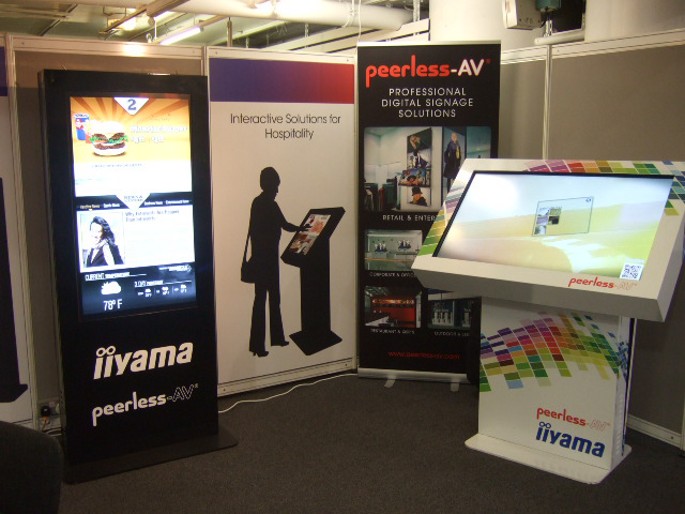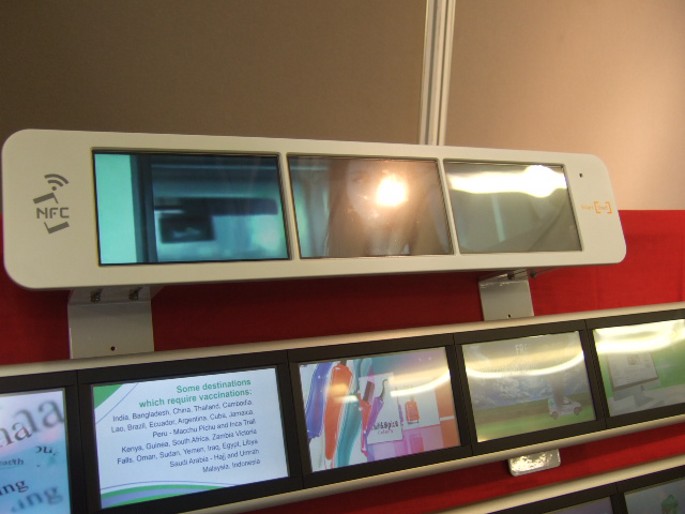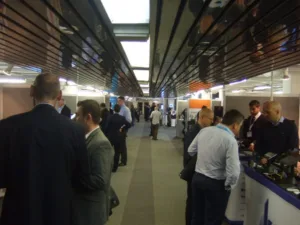Every year, HF Media & Events organises two shows in one: Kiosk London and Digital Signage London, which take place in London’s Barbican Centre. It is a small event, and two hours were more than enough time to see everyone we were interested in. While it was quiet when we arrived (to be fair, we got there even before the show opened!), we always hear from exhibitors that the quality of attendees is high.
10 Squared designs, installs and maintains DOOH hardware. Its business ranges from placing OEM screens into new enclosures, to full managed delivery of bespoke solutions. We were told about a big new project for the London Stock Exchange (definitely falling into the latter category), where 10 Squared built a rotating cube of square, thin-bezel Panasonic screens (which looked a lot like Christie Microtiles). The cube will replace a large sculpture on the second floor, and was meant to be installed on 13th October; however, the LSE has postponed the project.
Additionally, 10 Squared worked with Clear Channel on Walkers’ recent ‘Do Us a Flavour’ campaign (designing the mechanisms and software to dispense free packets of crisps). We also saw a prototype self-service kiosk for McDonalds, using an Android tablet as the display.
Airgoo produces digital signage screens (LCD and electrophoretic) and media players. It has recently merged with a German company and is using a new content management system (CMS) in all of its products. Airgoo supplies Android screens that do not require a media player, in 7″ – 21.5″ sizes. It has previously been unable to make its software compatible with similar products from other companies, but the acquisition has fixed that.
Airgoo has been targeting the entry-level segment, after eight years of trying to compete with larger brands like Broadsign and Scala. However, it has now settled back and is aiming at the entry-level and mid-range segments. Mercedes is a customer.
UltraHD is of interest to Airgoo, and the company has a new media player that can handle the format (at 30fps). It was showing the unit at Kiosk London to gauge customers’ reactions. If feedback is good, the company is ready to upgrade to 60fps.
Simon Chatt, director of Bauer Digital, works with signage company Inurface Media. He said that touch and vertical displays are a quickly-growing sector of the market. While large screens have been restricted to surface acoustic wave and IR touch in the past, Bauer is now developing procap touch for 32″ and 42″ screens. These should be available in Q2 next year.
We saw Peerless-AV at Technology Exposed in September (Display Monitor Vol 21 No 38), so there wasn’t much new to talk about. The company was promoting its partnership with Iiyama, which bundles an Iiyama screen, Peerless-AV vinyl wrap and software from Aztec. An Iiyama representative told us that Kiosk London had been very good last year – the company got two or three big leads – and a return was definitely justified.
‘Unusual’ signage displays are the focus of Semicom Visual, which was displaying small shelf screens, transparent and 3D models.
While Semicom has been offering a ‘Smart Shelf’ line for some time, it has redesigned these with the new SSS-483WN-V1. It is a row of three 4.8″ screens that are linked to show content from a single source. Resolution is 1920 x 540 across all three. Android 4.2 runs on an ARM Cortex-A9 CPU. NFC is also featured, so – for example – consumers could ‘pick up’ coupons. Touch enables the same function by entering a mobile number.
‘Semiview’ is a 46″ transparent display, which was developed a few years ago as a screen to be used as the windows of London Underground trains. The backlight would turn off when the train was stopped in a station (which are bright enough that it would not be required) and turn on when moving. Transport for London ultimately decided against the idea, though.
Semicon made a big claim with its (side-by-side) autostereoscopic 3D screen: it has apparently been proved to be the “Best in the market”. We questioned exactly how; sales director James Filmer said this was in regards to the viewing angles (160 deg ) and 3D views (eight). Viewing distances can be optimised to the customer’s requirements. Semicon can supply its glasses-free 3D technology to screens between 10.4″ and 72″.
The STT-4601 was the final product; a 46″, 32-point touch table containing two PCs. One PC is Windows and one is Android; customers can switch between them as needed. A 55″ model is also available.



